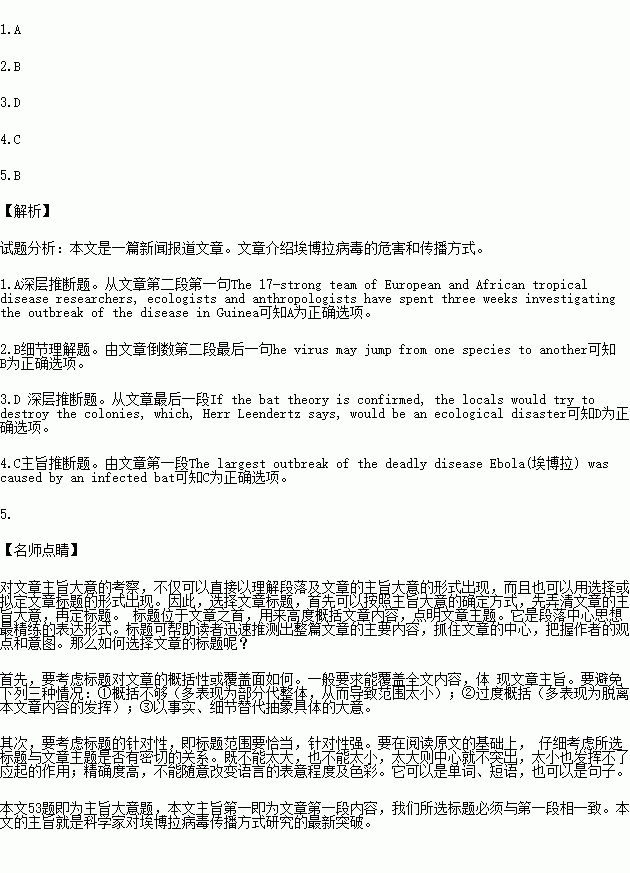题目内容
The largest outbreak of the deadly disease Ebola(埃博拉) was caused by an infected bat biting a toddler, say a group of international researchers.
The 17-strong team of European and African tropical disease researchers, ecologists and anthropologists have spent three weeks investigating the outbreak of the disease in Guinea, Liberia, Ivory Coast and Nigeria. The researchers captured the bats and other creatures near the village of Meliandoua in remote eastern Guinea, where the disease began in December 2013. The boy was bitten and passed the infection on to his mother and both died within a week. The disease was then spread far and wide by the people who came to the funeral.
Most of the previous outbreaks have been caused by meat from dead infected animals collected by hunters who then sell it on. Fruit bats, however, are widely eaten in rural West Africa.
The team, led by epidemiologist(流行病学家) Herr Leendertz, a disease ecologist at the Robert Koch Institute in Berlin, are expected to publish their results in a major journal soon.
Herr Leendertz’s team believe that an infected straw-colored fruit bat brought the disease to Guinea. The mammals are known to travel long distances and usually settle in forests near cities. Herr Leendertz said, “ The evidence is not 100 percent and we can only say that it is possible. They can travel far in one night. I don't think an individual bat or colony(群体) migrated all the way from Congo or Gabon to West Africa. These big colonies are connected. There is a possibility for the virus to mix between colonies. The bats share the same fruit. It is likely not to have even been one species of bat. The virus may jump from one species to another."
If the bat theory is confirmed, the locals would try to destroy the colonies, which, Herr Leendertz says, would be an ecological disaster, because bats pollinate(传授花粉) plants and kill insects. And bat hunts would also only increase human contact with potentially infected animals.
1.What’s the purpose of the 17-strong team?
A. To look into the outbreak of Ebola.
B. To help the people who suffer from Ebola.
C. To help cure the infected boy of Ebola.
D. To make a study of the bats including fruit bats.
2.In Herr Leendertz’s opinion, ______.
A. people can do nothing to prevent the disease
B. the disease Ebola may jump from one species to another
C. the result of the research should be published immediately
D. the straw-colored fruit bats usually settle in forests in the rural areas
3.If the bat theory is confirmed, ______.
A. the disease Ebola will be controlled
B. all the fruit bats in Africa would be killed
C. plants would not be pollinated in the future
D. the ecosystem in Africa might lose its balance
4.What’s the main idea of this passage?
A. A toddler was bitten by a bat and died.
B. The disease Ebola is incurable at present.
C. An infected bat caused the outbreak of Ebola.
D. The deadly disease Ebola broke out in Guinea.
5.This passage can probably be classified as ______.
A. a science fiction B. a news report
C. a lecture essay D. an auto-biography
 云南师大附小一线名师提优作业系列答案
云南师大附小一线名师提优作业系列答案 冲刺100分单元优化练考卷系列答案
冲刺100分单元优化练考卷系列答案书面表达
请根据内容提示,用英语Life in Senior Two 为题写一篇短文,叙述高二生活。
总体印象 | 激动、快乐、辛苦 |
实际生活 | 时间紧,常熬夜;作业多,考试多,克服困难,不断进步 |
生活态度 | 心中有梦,充满信心 |
注意:1.词数:120字左右;可适当添加细节,以使行文连贯;勿逐字翻译。
2.不能使用真实姓名和学校名称。
Life in Senior Two
________________________________________________________________________________________
________________________________________________________________________________________
________________________________________________________________________________________
________________________________________________________________________________________
________________________________________________________________________________________
________________________________________________________________________________________


